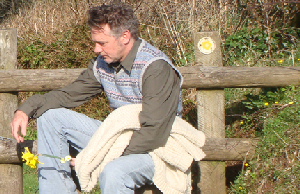Mark Olson has been making music for 25 years and has carved out a pretty distinguished niche for himself as a songwriter and musician, first with The Jayhawks, then with the Creekdippers, and lately as a solo artist. His recently released album, Many Colored Kite, is his second solo effort, and he has just kicked off a new tour to promote it, arriving in Louisville at the Rudyard Kipling this Saturday night.
When they formed the Jayhawks in 1985, Mark Olson and Gary Louris helped usher in and further define the resurgent roots-based sub-genre of music that most often goes by the name of alternative country (or rock) and sometimes Americana or No Depression. Attesting to his importance in that musical universe, Olson will be a keynote speaker at the 2011 International Folk Music Alliance in Memphis, TN. But if you think that he might be happily resting on his laurels as one of the seminal figures in a still-thriving and evolving genre, you'd be wrong.
In a recent conversation with Olson, I was struck by the excitement and enthusiasm he still has, not just for making music, but also discovering new trends and learning new techniques. He has spent a significant amount of time in Europe, playing clubs, honing his skills, and checking out the folk scene. There, he has discovered a new generation of youngsters, influenced by the great British folk guitarists of the 60s like John Martyn, John Renbourn, and Bert Jansch, who are learning to play an older style of “baroque folk.” Olson himself attended a guitar camp with Renbourn recently, where he said he learned a lot of great stuff.
“You go to England, and the minute you go to a pub and there are young people playing, they play in alternate tunings. They don't play in the straight tunings we play in. It's so interesting, and they're great over there at that kind of music.” As examples of the up-and-comers, he mentioned Norwegian Ane Brun and The Unthanks, who hail from Northumberland in Britain.
Olson thinks of himself as a lifelong learner. “I feel like I've gotten better these last four or five years. Things have really started to pick up on my level of playing and writing.”
One thing I noted from listening to Olson's Many Colored Kite was the impressionistic effect of his songs – they are more poem-like in their structure, relying on every-day, pastoral images of birds and rivers and flowers. I asked him if this was a conscious effort or just his natural expression.
“I had an uncle who was a Woodrow Wilson Scholarship poet, so I was just naturally attracted to words....How I found my voice was by thinking about my family, and thinking about very basic things and people and emotions...events. I've lived awhile and watched things and noticed things that happen around me and I put them upstairs, and then I just try to write something very simple and put words together in interesting ways that makes you think about something...the poetry thing is my main thing, really. That's how I think about music.”
All your leaves are colored red
There’s the kindest word
That brings in the tide
That lays bare the cold thorn tree
There’s no time reason or rhyme
There’s no time reason or rhyme
No time to live without her
Excerpt from “No Time to Live Without Her”
Literature nerd that I am, I was happy that I had hit on one of the elements that underpins Olson's style: “I've been doing this for a really long time, for 20 years, and I've done 500 music interviews and maybe one or two people have mentioned that I'm into poetry!”
The intricate guitar finger-picking on display in the album highlights the baroque element that Olson spoke of – simple lyrics married to more complex melodies and musical shapes, bringing to mind something of the strolling Renaissance troubadour.
Having last seen Olson at a Phoenix Hill show a couple of years ago performing with his old Jayhawks partner (they recorded Ready for the Flood together), I asked if there would be any further collaborations with Louris. Luckily for fans, they've already worked on a couple of songs, and Olson says they are planning to get back together after his current tour at some point.
Right now, though, Olson is happy to be on the road, and admits that he spends very little time at his cabin in Joshua Tree. He feels compelled to make the most of his time, which forms the basis of his advice to aspiring musicians. “The most important thing I would say, and it's not just music, but anything, would be to set your mind on doing it. I got started in my 20s playing music and when I look back all I can say is I wish during that time I would have taken it like I've taken it for the last four years...I've really given it my all. In the studio, in the writing, and touring....Treat it like something that's important to you. Pay attention to your music.”
Mark Olson will perform at the Rudyard Kipling Saturday, September 18 with opening guest Vandeveer. The show starts at 7:00 p.m and tickets can be purchased for $10 in advance at Ear X tacy or for $12 at Rudyard door.
Watch Mark Olson and Gary Louris perform “Turn Your Pretty Name Around” from Ready for the Flood. (Gorgeous!



